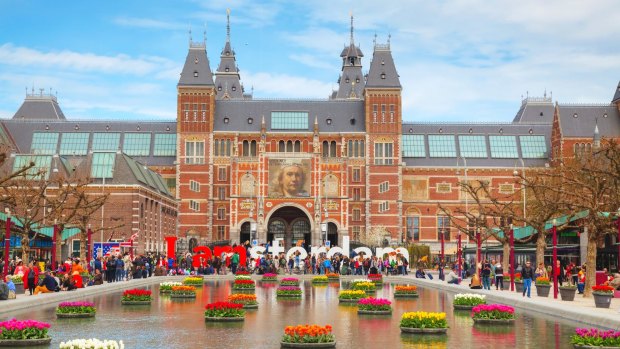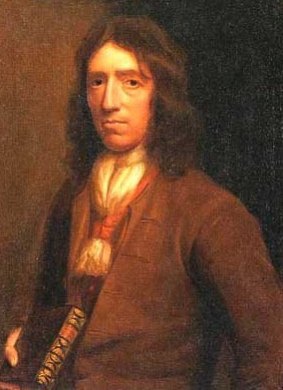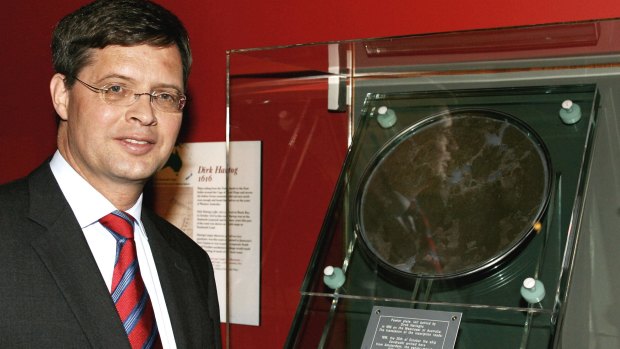This was published 7 years ago
Important parts of Australian history you have to go overseas for

Amsterdam's Rijksmuseum is home to the Dirk Hartog plate.Credit: iStock
Some of the most important cultural objects of Australian history can't be found in Australia. In fact, you may have to travel to the other side of the world to see them.
Dirk Hartog's plate
When Dutch East India company skipper Dirk Hartog got waylaid in 1616, he ended up skirting the West Australian coastline, becoming the first recorded European to see it. He also hopped ashore on a large island – now named Dirk Hartog Island in his honour – and had a pewter plate engraved as a sort of "I woz 'ere". It was the first verifiable documentation of a European landing in Australia.

William Dampier, explorer and naturalist.
He left the plate at Inscription Point on Dirk Hartog Island – now visitable on a tour via the Dirk Hartog Island Eco Lodge (www.dirkhartogisland.com/eco-lodge) – but it was later taken away by another Dutch explorer. The original plate is now in Amsterdam's Rijksmuseum. See www.Rijksmuseum.nl
William Dampier's collection
Dirk Hartog Island hogs more than its fair share of Australian history. In 1699, English explorer William Dampier also dropped by. He named the surrounding area Sharks Bay, which it is still called barring a dropped s. But, more importantly, he came aboard and collected a few plant species – the first ever collection of Australian flora by a European. Remarkably, the collection not only made it back home to Britain, but still survives to this day. It is preserved at the Sherardian Herbarium at Oxford University. See herbaria.plants.ox.ac.uk/bol/oxford

Former Dutch Prime Minister Jan Peter Balkenende next to the Hartog pewter plate during its temporary loan to the State Library of NSW in 2006.Credit: AP
Sydney Parkinson's drawings
Dampier may have collected the first flowers, but far larger scale botany research was done by Joseph Banks and Daniel Solander on board the Endeavour on Lt James Cook's history-making visit to Australia in 1770.
Banks and Solander did the collecting, but it was artist Sydney Parkinson who meticulously studied the plants and made drawings of them. These drawings became the early basis for much of what people on the other side of the world knew about Australia's flora. Today, the surviving Parkinson pictures form part of the Botany Library in London's Natural History Museum – and they can be viewed online, too. See http://www.nhm.ac.uk/our-science/departments-and-staff/library-and-archives/collections/cook-voyages-collection/endeavour-botanical-illustrations/about.dsml
The First Fleet collection
The Natural History Museum also plays host to the First Fleet Collection – 629 drawings and watercolours created by people who were on the First Fleet of convicts to land in Sydney back in 1788, mostly by Thomas Watling or George Raper.
The collection includes the first ever depictions of Port Jackson (aka Sydney Harbour) and several Australian animals. There's also a painting of Governor Arthur Phillip being stabbed in the shoulder by local Indigenous people at Manly Cove. See http://www.nhm.ac.uk/our-science/departments-and-staff/library-and-archives/collections/fleet-artwork-collection.html
Lachlan Macquarie's grave
Governor Macquarie is the man largely regarded as being responsible for Australia's transition from a penal colony to a potential country. He had things built, had the bush explored and founded several towns away from the original Sydney settlement. He also had a deliberate policy of emancipating convicts and encouraging them to become part of a new society on the other side of the world. Macquarie left Australia in 1822, though, and while he left his legacy in about 70 billion things named after himself, his grave can be found on the isle of Mull in Scotland. It's at Gruline, and is managed by the National Trust. See nts.org.uk.
Stuart's grave
Macquarie isn't the only legendary figure in Australian history buried in the UK. At the end of his life, John McDouall Stuart – the first man to cross Australia from south to north and make it back alive – returned to Britain at the end of his life. He's buried in the Kensal Green Cemetery in London, where an obelisk monument marks his plot. See www.kensalgreencemetery.com
Matthew Flinders' documents
Matthew Flinders was the first man to circumnavigate Australia, mapping much of the coastline on the way and popularising the name ''Australia'' for the continent. Much of his correspondence from his pioneering journeys – including plenty of the charts he made while mapping out the edges of Oz – are housed in London's National Maritime Museum. See flinders.rmg.co.uk
Gallipoli
The best known Australian historic site abroad is Gallipoli in Turkey, where the disastrous, nation-shaping First World War campaign took place. Several sites along the peninsula – including landing beaches, battlegrounds and cemeteries – have become part of an Australian pilgrimage trail undertaken by thousands every year. The Department of Veterans' Affairs has created a special site for would-be visitors. See www.gallipoli.gov.au
The Australian National Memorial
Gallipoli wasn't the only place that Australian soldiers fought during World War I, and more died on the Western Front, fighting in France and Belgium. Villers-Bretonneux on the Somme is home to the Australian National Memorial, on which the names of 11,000 Australian soldiers who were ''missing'' in France have been engraved. There's also an adjoining cemetery and nearby Franco-Australian Museum, which is currently being refurbished, but should reopen in late 2016. The memorial is one of 12 locations on an Australian Remembrance Trail along the Western Front. See www.ww1westernfront.gov.au/villers-bretonneux and www.museeaustralien.com
The Kokoda Track
Of Australia's campaigns in World War II, the Kokoda Track comes closest to evoking Gallipoli. Over 96 kilometres of brutal mountainous, jungle terrain in Papua New Guinea's Owen Stanley Range, Australian troops fought a series of defensive battles against advancing Japanese troops. The Japanese were held off, and didn't get to Port Moresby, from where a series of bombing raids on Queensland were planned. The Track is still gruelling, and often undertaken as a fitness challenge. Memorials and battlegrounds are along the route. See kokoda.commemoration.gov.au
See also: How did a convicted forger end up on the $10 note?
See also: The untouched Aussie islands home to a notorious horror
Sign up for the Traveller Deals newsletter
Get exclusive travel deals delivered straight to your inbox. Sign up now.